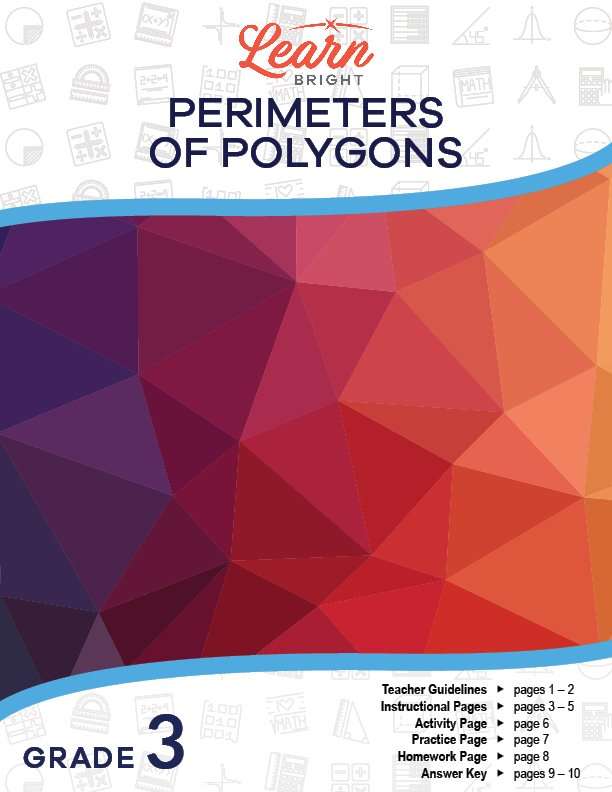Description
What our Perimeters of Polygons lesson plan includes
Lesson Objectives and Overview: Perimeters of Polygons teaches students how to find the perimeter of a polygon. In order to do this, students learn the definition of a polygon and how to identify them. At the end of the lesson, students will be able to determine the perimeter of regular and irregular polygons; identify the missing length when the perimeter of a polygon is given. This lesson is for students in 3rd grade.
Classroom Procedure
Every lesson plan provides you with a classroom procedure page that outlines a step-by-step guide to follow. You do not have to follow the guide exactly. The guide helps you organize the lesson and details when to hand out worksheets. It also lists information in the blue box that you might find useful. You will find the lesson objectives, state standards, and number of class sessions the lesson should take to complete in this area. In addition, it describes the supplies you will need as well as what and how you need to prepare beforehand.
Options for Lesson
Included with this lesson is an “Options for Lesson” section that lists a number of suggestions for activities to add to the lesson or substitutions for the ones already in the lesson. One optional adjustment to the lesson activity is to have your students use the school’s playground and use chalk to draw and measure regular large regular and irregular polygons. For an additional activity, you could have your students use hands-on materials to create irregular polygons and then measure the perimeters. You could also have your students measure the perimeters of objects in the classroom or the school that may include regular and irregular polygons. Finally, you could discuss the reasons for finding perimeters in real-world situations.
Teacher Notes
The teacher notes page includes a paragraph with additional guidelines and things to think about as you begin to plan your lesson. This page also includes lines that you can use to add your own notes as you’re preparing for this lesson.
PERIMETERS OF POLYGONS LESSON PLAN CONTENT PAGES
Regular Polygon Perimeter
The Perimeters of Polygons lesson plan includes three content pages. Perimeter is the distance around the outside of a shape or area. You can measure distance in centimeters, inches, feet, miles, or any other standard or metric unit of measure.
Up to this point, students have likely mostly practiced finding the perimeter of squares and rectangles. However, it’s also easy to find the perimeters of other polygons (both regular and irregular) by measuring around the outside of the shape.
Pentagons
Regular polygons are figures with equal angles and sides. A pentagon (a 5-sided polygon) is an example of a regular polygon. To find the perimeter of a pentagon, you find the length of one side and multiply it by five.
The lesson shows drawings of a few example regular polygons, all of which are pentagons. Remember that you only need to measure one side of a pentagon to find its perimeter. You multiply that measurement by five to find the perimeter.
The first example pentagon has a side with a measurement of 2 centimeters. To find its perimeter, multiply the length of that side by five: 2 x 5 = 10. Therefore, the perimeter of that pentagon is 10 centimeters. The other example pentagons have side measurements of 6 inches and 6 feet. To find their perimeters, you multiply by five: 6 x 5 = 30. Therefore, their perimeters are 30 inches and 30 feet.
Other Regular Polygons
Pentagons are not the only regular polygons. Some other regular polygons include quadrilaterals (4 sides), hexagons (6 sides), heptagons (7 sides), and octagons (8 sides). To find the perimeter of these figures, you measure one side of the regular polygon and then multiply the measurement by the number of sides of the regular polygon.
The lesson includes a few drawings of example polygons. The first example polygon is a hexagon with a side measurement of 4 inches. To find the perimeter, you multiply the side measurement (4) by the number of sides of the regular polygon (hexagons have six sides, so you multiply by 6): 4 x 6 = 24. Therefore, the perimeter of this hexagon is 24 inches.
The next example is a heptagon with a side measurement of 2 feet. To solve, multiply the side measurement by the number of sides: 2 x 7 = 14. Therefore, the perimeter of this heptagon is 14 feet.
The final example is an octagon with a side measurement of 7 meters. To solve, multiply the side measurement by the number of sides: 7 x 8 = 56. Therefore, the perimeter of this octagon is 56 meters.
Always remember that you only need one measurement to find the perimeter of a regular polygon!
Irregular Polygon Perimeter
To find the perimeter of an irregular polygon, which does not have equal sides and angles, you need to measure all the figure’s sides. Some irregular polygons have two equal sides, but not all of the sides are equal.
The lesson includes two example drawings of irregular polygons. The first example is an 8-sided irregular polygon with side measurements of 2, 4, 3, 2.5, 2, 4, 3, and 2.5 inches. To find its perimeter, you add the side measurements together: 2 + 4 + 3 + 2.5 + 2 + 4 + 3 + 2.5 = 23. Therefore, its perimeter is 23 inches.
The second example is a 5-sided irregular polygon with side measurements of 6, 12, 8, 5.5, and 5 centimeters. To find its perimeter, you add the side measurements together: 6 + 12 + 8 + 5.5 + 5 = 36.5. Therefore, its perimeter is 36.5 centimeters.
While measuring each side takes a little more time than measuring one side and multiplying, it’s a necessary step for finding the perimeter of an irregular polygon.
PERIMETERS OF POLYGONS LESSON PLAN WORKSHEETS
The Perimeters of Polygons lesson plan includes three worksheets: an activity worksheet, a practice worksheet, and a homework assignment. You can refer to the guide on the classroom procedure page to determine when to hand out each worksheet.
PLAYGROUNDS ACTIVITY WORKSHEET
Students will work with a partner to complete the lesson activity. Each pair will create plans for two playgrounds: one with a fence shaped like a regular polygon and the other with a fence shaped like an irregular polygon. They will include measurements for the fences.
TRUE OR FALSE PRACTICE WORKSHEET
For the practice worksheet, students will first tell whether five statements related to polygons are true or false. They will also determine whether the six polygons shown on the worksheet are regular or irregular and find the perimeter of each.
PERIMETERS OF POLYGONS HOMEWORK ASSIGNMENT
The homework assignment asks students to follow the directions to draw four images. They will also find the perimeter of different polygons.
Worksheet Answer Keys
This lesson plan includes answer keys for the practice worksheet and the homework assignment. If you choose to administer the lesson pages to your students via PDF, you will need to save a new file that omits these pages. Otherwise, you can simply print out the applicable pages and keep these as reference for yourself when grading assignments.









